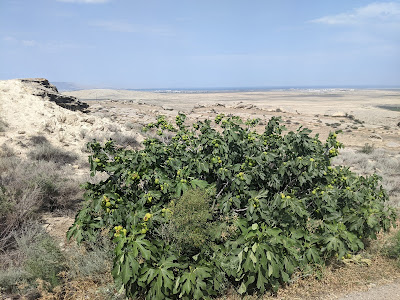After a week in the beautiful city of Baku I'm heading south to the Hirkan National Park on the Iranian border. On the way are the flat-top mountains and active mud volcanoes of Gobustan that have been home to humans for 10's of thousands of years. This is evident by the 6000+ petroglyphs, ancient rock carvings that depict animals, people, and religious symbols, that can be found in the area. During this post we'll take a look at some of the rock carvings and plants that grow among the rocky terrain, with a focus on the edible species.
About 64 km southwest of Baku just off the coastal road heading inland you enter Gobustan National Park, an extraordinary tapestry of ancient wonders. It's hard to believe when looking over the rugged landscapes and weathered rock formations that in the past the area was a lush forest but not so difficult to believe why our ancient ancestors would have choose this location to settle. The high ground provides excellent 360 views of the surrounding area, the terrain provides great rainwater catchment potential and the sea is nearby.
The museaum before the park is really good and provides a great overview of the area and the petroglyphs of this UNESCO World Heritage Site. The oldest petroglyphs are thought to be around 40000 years old. Included in the carvings are boats (right) which is a pretty good indicator that this technology was around during the prehistoric period.
Support Our Project
If you appreciate the work we are doing you can show your support in several ways.
Become a member of the Bloom Room. A $70 annual or $7 per month subscription to our Substack provides you with access to live sessions, design tutorials, a members forum and more, see details here.
Make a purchase of plants or seeds from our Nursery or Online Store
Joining us for one of our Practical Courses or Online Courses
Comment, like, and share our content on social media.
If you appreciate the work we are doing you can show your support in several ways.
Become a member of the Bloom Room. A $70 annual or $7 per month subscription to our Substack provides you with access to live sessions, design tutorials, a members forum and more, see details here.
Make a purchase of plants or seeds from our Nursery or Online Store
Joining us for one of our Practical Courses or Online Courses
Comment, like, and share our content on social media.
Want to learn more about Regenerative Landscape Design? Join The Bloom Room!
The Bloom Room is designed to create a space for more in-depth learning, for sharing projects and ideas, for seeking advice and discovering opportunities.
Ultimately, it aims to build a more intimate, interactive, and actionable relationship between members, a way for the Bloom Room community to support each other’s projects and learning journeys, and to encourage and facilitate the design, build, and management of more regenerative landscapes across our planet.
What you can expect as a member of the Bloom Room
As a member of the Bloom Room you can expect;
Access to an interactive forum where you can ask questions, direct what type of content you would like to see as well as share your own content and projects.
Monthly live session featuring general Q&A and tutorials on design software for creating and presenting polycultures.
Live session every month for members to showcase your projects, plans, designs, and gardens, with guest speakers from the community.
Full Access to all of the content on Substack
A 50% discounts on all of our online courses
Future opportunities to join our Global Regenerative Landscape Design and Consultancy Service, with potential roles for those with the will and skill to join our design team.
An opportunity to take part in the group ownership of a Regenerative Landscape. You will find more details on that here.
Become a paid subscriber to our Substack to join. The annual subscription is currently $70 and the monthly subscription is $7 (monthly subscription excludes discounts for products and services) . You can join here, we look forward to meeting you!
Regenerative Landscape Design - Online Interactive Course
Want to learn how to design, build and manage regenerative landscapes? Join us on our Regenerative Landscape Design - Online Interactive Course. We look forward to providing you with the confidence, inspiration, and opportunity to design, build and manage regenerative landscapes, gardens, and farms that produce food and other resources for humans while enhancing biodiversity.
You can find the course details here and at the moment we have a $350 ( 20%) discount for full enrollment to the course. Just use RLD2024 in the promo code section of the registration form to receive your discount.
























Indulge in a luxurious travel experience with DHT Holidays' Azerbaijan tour packages. Whether you're captivated by the modern cityscapes of Baku or yearning to explore the rugged beauty of the Caucasus Mountains, our expertly crafted itineraries cater to every traveler's dream. Book now and let us take you on a remarkable adventure through Azerbaijan.
ReplyDelete